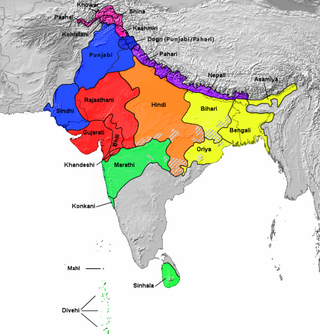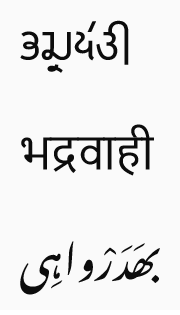
Kashmiri or Koshur is a Dardic Indo-Aryan language spoken by around 7 million Kashmiris of the Kashmir region, primarily in the Kashmir Valley of the Indian-administrated union territory of Jammu and Kashmir. Kashmiri has split ergativity and the unusual verb-second word order.

The Northern Indo-Aryan languages, also known as Pahāṛi languages, are a proposed group of Indo-Aryan languages spoken in the lower ranges of the Himalayas, from Nepal in the east, through the Indian states of Jammu and Kashmir, Uttarakhand, Himachal Pradesh and Punjab was coined by G. A. Grierson.

Pahari-Pothwari is an Indo-Aryan language variety of Lahnda group, spoken on the Pothohar Plateau in the far north of Punjab, Pakistan, as well as in most of Pakistan-administered Azad Kashmir and in western areas of Indian-administered Jammu and Kashmir, is known by a variety of names, the most common of which are Pahari, and Pothwari.
The Western Pahari languages are a group of Northern Indo-Aryan languages spoken in Northern India, primarily in the state of Himachal Pradesh, Jammu division, parts of Pakistan-administered Kashmir and the Punjab region.

Dogri is an Indo-Aryan language primarily spoken in the Jammu region of Jammu and Kashmir, India, with smaller groups of speakers in adjoining regions of western Himachal Pradesh, northern Punjab, and north-eastern Pakistani Punjab. It is the ethnic language of the Dogras, and was spoken in the historical region of Greater Duggar. Currently in Districts : Kathua, Jammu, Samba, Udhampur, and Reasi, These district residents also speak Kashmiri, Hindi, Urdu and Punjabi. Dogri is a member of the Western Pahari group of languages. Unusually for an Indo-European language, Dogri is tonal, a trait it shares with other Western Pahari languages and Punjabi. It has several varieties, all with greater than 80% lexical similarity.

Shina is a Dardic language of Indo-Aryan language family spoken by the Shina people. In Pakistan, Shina is the major language in Gilgit-Baltistan spoken by an estimated 1,146,000 people living mainly in Gilgit-Baltistan and Kohistan. A small community of Shina speakers is also found in India, in the Guraiz valley of Jammu and Kashmir and in Dras valley of Ladakh. Outliers of Shina language such as Brokskat are found in Ladakh, Kundal Shahi in Azad Kashmir, Palula and Sawi in Chitral, Ushojo in the Swat Valley and Kalkoti in Dir.

The Tākri script is an abugida writing system of the Brahmic family of scripts. It is derived from the Sharada script formerly employed for Kashmiri. It is the sister script of Laṇḍā scripts. It has another variant Dogra Takri employed in Jammu region. There are numerous varieties present throughout Himachal Pradesh. Until the late 1940s, the adapted version of the script was the official script for writing Dogri in the princely state of Jammu and Kashmir. Throughout the history, different kingdoms of what now forms Himachal Pradesh used their own variety to maintain their records. The Takri script used in Sirmour in Himachal Pradesh and in the adjacent region of Jaunsar-Bawar in Uttarakhand has some distinction.
Pahari, or Pahadi is an ambiguous term that has been used for a variety of languages, dialects and language groups, most of which are found in the lower Himalayas.

Bhadarwahi (Bhadrawahi) is an Indo-Aryan language of the Western Pahari group spoken by the Bhadarwahi people of the Bhaderwah region of Indian administered Jammu and Kashmir.
Padri is a dialect spoken in the Padar valley in Kishtwar district in the Indian territory of Jammu and Kashmir. It belongs to the Bhadarwahi group of dialects, and is classified as a member of the Western Pahari branch of the Indo-Aryan languages. It is very similar to the Pangwali language of Pangi, Himachal Pradesh.
Siddheshwar Varma (1887–1985) was an Indian linguist, phonetician, grammarian and scholar, known for his knowledge of over 30 languages. He was the secretary of the International Moral Education Congress for India (1923) and the author of such books as The Bhalesī dialect, A Glossary of the Khāsī : a north-western Himalayan dialect of Jammu and Kashmir, Siddha-Bhāratī; The rosary of Indology and Pahari dictionary of 27-north-western Himalayan dialects. The Government of India awarded him the third highest civilian honour of the Padma Bhushan, in 1957, for his contributions to literature and education.

Kishtwari or Kashtwari is a northern Indo-Aryan language closely related to the Kashmiri language, with strong influences from neighboring Western Pahari varieties, spoken in the Kishtwar district of Jammu and Kashmir, India.

Sarazi or Sirazi is an Indo-Aryan language spoken in the Saraz region of the Jammu division of Jammu and Kashmir, India. It is native to the Saraz region, a hilly area taking up the northern half of Doda district and parts of neighbouring Ramban and Kishtwar districts. Sarazi is spoken as a first language by 46,000 people, primarily Hindus, but it is also used as a lingua franca of the Saraz region and so is also spoken as a second language by Muslims, whom are native speakers of Kashmiri.

Pangwali is a Western Pahari language of Himachal Pradesh, India. It is spoken in the Pangi Tehsil of Chamba district, and is threatened to go extinct. Pangwali is natively written in the Takri script, but Devanagari is used as well. It is very similar to the Padderi language of Padder, J&K.

Bhalessa is a geographical area within Doda district in the Jammu region of India-administered Kashmir. It consists of the Bunjwah and Bhalessa Valleys, and comprises the three Tehsils of Kahara, Chilly Pingal and Gandoh.

Gaddi is an Indo-Aryan language of India. It is spoken by the Gaddi people primarily residing in Bharmour region of Chamba district and upper reaches of Kangra district in Himachal Pradesh. It is also spoken in neighbouring parts of Jammu, with Gaddi villages found in Udhampur, Kathua and Doda districts.
Khāṣi is an Indo-Aryan dialect of Jammu and Kashmir, India. It belongs to the Western Pahari group and is spoken in some of the mountainous areas north of Jammu.
The Pahari people or Pahari-speaking people is a cover term for a number of heterogeneous communities inhabiting in Jammu and Kashmir and also some parts of Pakistan administered Azad Kashmir who speak Pahari languages/dialects.
Pogali, or Poguli, is an Indo-Aryan language spoken in parts of the Chenab Valley in Jammu region of Jammu and Kashmir, India. Its area encompasses the Pogal and Paristan, Ramsu Banihal Khari Reasi valleys, and currently falls within the boundaries of Ramban district's Pogal Paristan tehsil.Poguli, while based on Kashmiri, is much mixed with Pahari and Lahndâ, and forms a transition dialect. In 1911 the number of speakers was reported to be 8,158.Like its neighbours Sarazi and Rambani, Poguli is intermediate between Kashmiri and Western Pahari.
Rambani is an Indo-Aryan language variety spoken in Ramban district, which is located in the mountainous parts of the Jammu region of Jammu and Kashmir, India.














